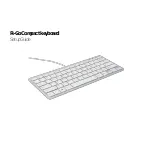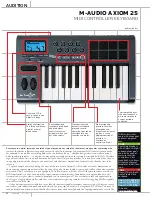
User s Reference Manual of KB-78 Keyboard
- 11 -
4.5 How to Define a Key with a String of Characters
Follow step 3 & 4 and then substitute the following commands:
Step 24: Use the arrow keys to move the highlighted bar to the
"KEY STRING
DEFINE
–
option and press <Enter>
Step 25: Following message will be displayed at the top left of matrix as follows:
KEY STRING DEFINE
USE LEFT, RIGHT, UP, DOWN TO SELECT AND ENTER TO CHANGE
Use the arrow keys to move around the matrix to a key of your choice and
press <Enter> to select that key for editing.
Step 26: Following message will be displayed at the top left of matrix as follows:
KEY STRING DEFINE
INPUT KEY STRING: 1 - 78
Step 27: Input the Key positions number you wish to edit.
Step 28: Press <Enter> for editing. The selected Key position is highlighted.
Step 29: Type a string of characters to a maximum of 16 strokes (or characters).
Step 30: Press <Enter>. The selected Key is defined as a string of characters.
Step 31: Continue from step 10.
NOTE
: The shift key acts as a shift-lock toggle key in this mode.
4.6 How to assign a key with Null Function
When a key is programmed as a Null Key, it will not send a key code when pressed.
Null keys are required when you use 1 x 2 or 2 x 2 keycaps. For example, if you use a
2 x 2 keycap covering 4 keys, 3 of the keys should be set as null keys.
Follow steps 3 & 4 and then substitute the following commands:
Step 32: Use the arrow keys to move the highlighted bar to the
"NULL KEY DEFINE
–
option and press <Enter>.
Step 33: Following message will be displayed at the top left of matrix as follows:
NULL KEY DEFINE
INPUT KEY POSITION: 1 78
Step 34: Input the Key positions number of the key you wish to program as a null key
and press <Enter>. The selected key is now programmed as a null key.
Step 35: Continue from Step 10.
NOTE
: The 10 keypad is not functional in this mode.

































